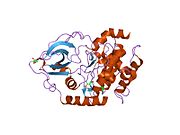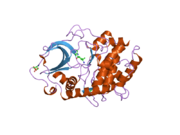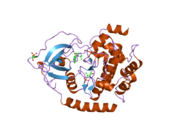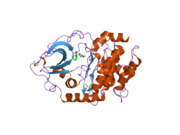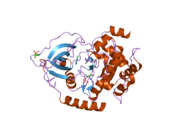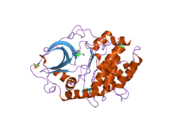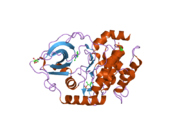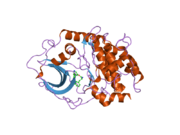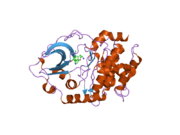-
1apm: 2.0 ANGSTROM REFINED CRYSTAL STRUCTURE OF THE CATALYTIC SUBUNIT OF CAMP-DEPENDENT PROTEIN KINASE COMPLEXED WITH A PEPTIDE INHIBITOR AND DETERGENT
-
1atp: 2.2 angstrom refined crystal structure of the catalytic subunit of cAMP-dependent protein kinase complexed with MNATP and a peptide inhibitor
-
1bkx: A BINARY COMPLEX OF THE CATALYTIC SUBUNIT OF CAMP-DEPENDENT PROTEIN KINASE AND ADENOSINE FURTHER DEFINES CONFORMATIONAL FLEXIBILITY
-
1bx6: CRYSTAL STRUCTURE OF THE POTENT NATURAL PRODUCT INHIBITOR BALANOL IN COMPLEX WITH THE CATALYTIC SUBUNIT OF CAMP-DEPENDENT PROTEIN KINASE
-
1cdk: CAMP-DEPENDENT PROTEIN KINASE CATALYTIC SUBUNIT (E.C.2.7.1.37) (PROTEIN KINASE A) COMPLEXED WITH PROTEIN KINASE INHIBITOR PEPTIDE FRAGMENT 5-24 (PKI(5-24) ISOELECTRIC VARIANT CA) AND MN2+ ADENYLYL IMIDODIPHOSPHATE (MNAMP-PNP) AT PH 5.6 AND 7C AND 4C
-
1cmk: CRYSTAL STRUCTURES OF THE MYRISTYLATED CATALYTIC SUBUNIT OF CAMP-DEPENDENT PROTEIN KINASE REVEAL OPEN AND CLOSED CONFORMATIONS
-
1ctp: STRUCTURE OF THE MAMMALIAN CATALYTIC SUBUNIT OF CAMP-DEPENDENT PROTEIN KINASE AND AN INHIBITOR PEPTIDE DISPLAYS AN OPEN CONFORMATION
-
1fmo: CRYSTAL STRUCTURE OF A POLYHISTIDINE-TAGGED RECOMBINANT CATALYTIC SUBUNIT OF CAMP-DEPENDENT PROTEIN KINASE COMPLEXED WITH THE PEPTIDE INHIBITOR PKI(5-24) AND ADENOSINE
-
1j3h: Crystal structure of apoenzyme cAMP-dependent protein kinase catalytic subunit
-
1jbp: Crystal Structure of the Catalytic Subunit of cAMP-dependent Protein Kinase Complexed with a Substrate Peptide, ADP and Detergent
-
1jlu: Crystal Structure of the Catalytic Subunit of cAMP-dependent Protein Kinase Complexed with a Phosphorylated Substrate Peptide and Detergent
-
1l3r: Crystal Structure of a Transition State Mimic of the Catalytic Subunit of cAMP-dependent Protein Kinase
-
1q24: PKA double mutant model of PKB in complex with MgATP
-
1q61: PKA triple mutant model of PKB
-
1q62: PKA double mutant model of PKB
-
1q8t: The Catalytic Subunit of cAMP-dependent Protein Kinase (PKA) in Complex with Rho-kinase Inhibitor
Y-27632
-
1q8u: The Catalytic Subunit of cAMP-dependent Protein Kinase in Complex with Rho-kinase Inhibitor H-1152P
-
1q8w: The Catalytic Subunit of cAMP-dependent Protein Kinase in Complex with Rho-kinase Inhibitor Fasudil (HA-1077)
-
1rdq: Hydrolysis of ATP in the crystal of Y204A mutant of cAMP-dependent protein kinase
-
1re8: Crystal structure of cAMP-dependent protein kinase complexed with balanol analog 2
-
1rej: Crystal structure of cAMP-dependent protein kinase complexed with balanol analog 1
-
1rek: Crystal structure of cAMP-dependent protein kinase complexed with balanol analog 8
-
1smh: Protein kinase A variant complex with completely ordered N-terminal helix
-
1stc: CAMP-DEPENDENT PROTEIN KINASE, ALPHA-CATALYTIC SUBUNIT IN COMPLEX WITH STAUROSPORINE
-
1sve: Crystal Structure of Protein Kinase A in Complex with Azepane Derivative 1
-
1svg: Crystal Structure of Protein Kinase A in Complex with Azepane Derivative 4
-
1svh: Crystal Structure of Protein Kinase A in Complex with Azepane Derivative 8
-
1syk: Crystal structure of E230Q mutant of cAMP-dependent protein kinase reveals unexpected apoenzyme conformation
-
1szm: DUAL BINDING MODE OF BISINDOLYLMALEIMIDE 2 TO PROTEIN KINASE A (PKA)
-
1veb: Crystal Structure of Protein Kinase A in Complex with Azepane Derivative 5
-
1xh4: Crystal Structures of Protein Kinase B Selective Inhibitors in Complex with Protein Kinase A and Mutants
-
1xh5: Crystal Structures of Protein Kinase B Selective Inhibitors in Complex with Protein Kinase A and Mutants
-
1xh6: Crystal Structures of Protein Kinase B Selective Inhibitors in Complex with Protein Kinase A and Mutants
-
1xh7: Crystal Structures of Protein Kinase B Selective Inhibitors in Complex with Protein Kinase A and Mutants
-
1xh8: Crystal Structures of Protein Kinase B Selective Inhibitors in Complex with Protein Kinase A and Mutants
-
1xh9: Crystal Structures of Protein Kinase B Selective Inhibitors in Complex with Protein Kinase A and Mutants
-
1xha: Crystal Structures of Protein Kinase B Selective Inhibitors in Complex with Protein Kinase A and Mutants
-
1ydr: STRUCTURE OF CAMP-DEPENDENT PROTEIN KINASE, ALPHA-CATALYTIC SUBUNIT IN COMPLEX WITH H7 PROTEIN KINASE INHIBITOR 1-(5-ISOQUINOLINESULFONYL)-2-METHYLPIPERAZINE
-
1yds: STRUCTURE OF CAMP-DEPENDENT PROTEIN KINASE, ALPHA-CATALYTIC SUBUNIT IN COMPLEX WITH H8 PROTEIN KINASE INHIBITOR [N-(2-METHYLAMINO)ETHYL]-5-ISOQUINOLINESULFONAMIDE
-
1ydt: STRUCTURE OF CAMP-DEPENDENT PROTEIN KINASE, ALPHA-CATALYTIC SUBUNIT IN COMPLEX WITH H89 PROTEIN KINASE INHIBITOR N-[2-(4-BROMOCINNAMYLAMINO)ETHYL]-5-ISOQUINOLINE
-
2c1a: STRUCTURE OF CAMP-DEPENDENT PROTEIN KINASE COMPLEXED WITH ISOQUINOLINE-5-SULFONIC ACID (2-(2-(4-CHLOROBENZYLOXY) ETHYLAMINO)ETHYL)AMIDE
-
2c1b: STRUCTURE OF CAMP-DEPENDENT PROTEIN KINASE COMPLEXED WITH (4R,2S)-5'-(4-(4-CHLOROBENZYLOXY)PYRROLIDIN-2-YLMETHANESULFONYL)ISOQUINOLINE
-
2cpk: CRYSTAL STRUCTURE OF THE CATALYTIC SUBUNIT OF CYCLIC ADENOSINE MONOPHOSPHATE-DEPENDENT PROTEIN KINASE
-
2erz: Crystal Structure of c-AMP Dependent Kinase (PKA) bound to hydroxyfasudil
-
2f7e: PKA complexed with (S)-2-(1H-Indol-3-yl)-1-(5-isoquinolin-6-yl-pyridin-3-yloxymethyl-etylamine
-
2f7x: Protein Kinase A bound to (S)-2-(1H-Indol-3-yl)-1-[5-((E)-2-pyridin-4-yl-vinyl)-pyridin-3-yloxymethyl]-ethylamine
-
2f7z: Protein Kinase A bound to (R)-1-(1H-Indol-3-ylmethyl)-2-(2-pyridin-4-yl-[1,7]naphtyridin-5-yloxy)-ehylamine
-
2gfc: cAMP-dependent protein kinase PKA catalytic subunit with PKI-5-24
-
2gnf: Protein kinase A fivefold mutant model of Rho-kinase with
Y-27632
-
2gng: Protein kinase A fivefold mutant model of Rho-kinase
-
2gnh: PKA five fold mutant model of Rho-kinase with H1152P
-
2gni: PKA fivefold mutant model of Rho-kinase with inhibitor Fasudil (HA1077)
-
2gnj: PKA three fold mutant model of Rho-kinase with
Y-27632
-
2gnl: PKA threefold mutant model of Rho-kinase with inhibitor H-1152P
-
2gu8: Discovery of 2-Pyrimidyl-5-Amidothiophenes as Novel and Potent Inhibitors for AKT: Synthesis and SAR Studies
-
2jds: STRUCTURE OF CAMP-DEPENDENT PROTEIN KINASE COMPLEXED WITH A-443654
-
2jdt: STRUCTURE OF PKA-PKB CHIMERA COMPLEXED WITH ISOQUINOLINE-5-SULFONIC ACID (2-(2-(4-CHLOROBENZYLOXY) ETHYLAMINO)ETHYL) AMIDE
-
2jdv: STRUCTURE OF PKA-PKB CHIMERA COMPLEXED WITH A-443654
-
2oh0: Crystal structure of Protein Kinase A in complex with Pyridine-Pyrazolopyridine Based Inhibitors
-
2ojf: Crystal structure of Protein Kinase A in complex with Pyridine-Pyrazolopyridine based inhibitors
-
2uvx: STRUCTURE OF PKA-PKB CHIMERA COMPLEXED WITH 7-AZAINDOLE
-
2uvy: STRUCTURE OF PKA-PKB CHIMERA COMPLEXED WITH METHYL-(4-(9H-PURIN-6-YL)-BENZYL)-AMINE
-
2uvz: STRUCTURE OF PKA-PKB CHIMERA COMPLEXED WITH C-PHENYL-C-(4-(9H-PURIN-6-YL)-PHENYL)-METHYLAMINE
-
2uw0: STRUCTURE OF PKA-PKB CHIMERA COMPLEXED WITH 6-(4-(4-(4-CHLORO-PHENYL)-PIPERIDIN-4-YL)-PHENYL)-9H-PURINE
-
2uw3: STRUCTURE OF PKA-PKB CHIMERA COMPLEXED WITH 5-METHYL-4-PHENYL-1H-PYRAZOLE
-
2uw4: STRUCTURE OF PKA-PKB CHIMERA COMPLEXED WITH 2-(4-(5-METHYL-1H-PYRAZOL-4-YL)-PHENYL)-ETHYLAMINE
-
2uw5: STRUCTURE OF PKA-PKB CHIMERA COMPLEXED WITH (R)-2-(4-CHLORO-PHENYL)-2-(4-1H-PYRAZOL-4-YL)-PHENYL)-ETHYLAMINE
-
2uw6: STRUCTURE OF PKA-PKB CHIMERA COMPLEXED WITH (S)-2-(4-CHLORO-PHENYL)-2-(4-1H-PYRAZOL-4-YL)-PHENYL)-ETHYLAMINE
-
2uw7: STRUCTURE OF PKA-PKB CHIMERA COMPLEXED WITH 4-(4-CHLORO-PHENYL)-4-(4-(1H-PYRAZOL-4-YL)-PHENYL)-PIPERIDINE
-
2uw8: STRUCTURE OF PKA-PKB CHIMERA COMPLEXED WITH 2-(4-CHLORO-PHENYL)-2-PHENYL-ETHYLAMINE
-
2uzt: PKA STRUCTURES OF AKT, INDAZOLE-PYRIDINE INHIBITORS
-
2uzu: PKA STRUCTURES OF INDAZOLE-PYRIDINE SERIES OF AKT INHIBITORS
-
2uzv: PKA STRUCTURES OF INDAZOLE-PYRIDINE SERIES OF AKT INHIBITORS
-
2uzw: PKA STRUCTURES OF INDAZOLE-PYRIDINE SERIES OF AKT INHIBITORS
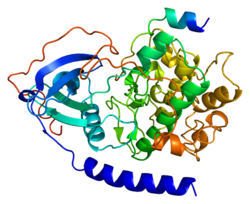




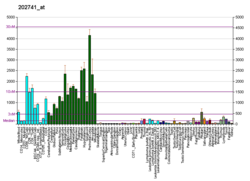

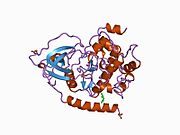












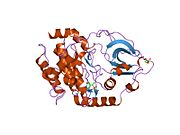


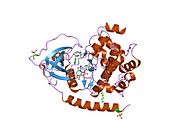








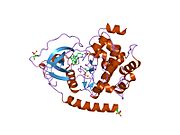




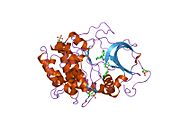




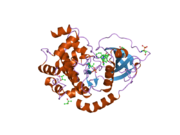

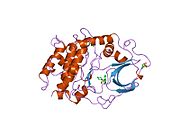
![1yds: STRUCTURE OF CAMP-DEPENDENT PROTEIN KINASE, ALPHA-CATALYTIC SUBUNIT IN COMPLEX WITH H8 PROTEIN KINASE INHIBITOR [N-(2-METHYLAMINO)ETHYL]-5-ISOQUINOLINESULFONAMIDE](https://upload.wikimedia.org/wikipedia/commons/thumb/d/dd/PDB_1yds_EBI.jpg/180px-PDB_1yds_EBI.jpg)
![1ydt: STRUCTURE OF CAMP-DEPENDENT PROTEIN KINASE, ALPHA-CATALYTIC SUBUNIT IN COMPLEX WITH H89 PROTEIN KINASE INHIBITOR N-[2-(4-BROMOCINNAMYLAMINO)ETHYL]-5-ISOQUINOLINE](https://upload.wikimedia.org/wikipedia/commons/thumb/5/54/PDB_1ydt_EBI.jpg/180px-PDB_1ydt_EBI.jpg)




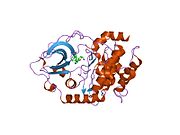
![2f7x: Protein Kinase A bound to (S)-2-(1H-Indol-3-yl)-1-[5-((E)-2-pyridin-4-yl-vinyl)-pyridin-3-yloxymethyl]-ethylamine](https://upload.wikimedia.org/wikipedia/commons/thumb/3/36/PDB_2f7x_EBI.jpg/180px-PDB_2f7x_EBI.jpg)
![2f7z: Protein Kinase A bound to (R)-1-(1H-Indol-3-ylmethyl)-2-(2-pyridin-4-yl-[1,7]naphtyridin-5-yloxy)-ehylamine](https://upload.wikimedia.org/wikipedia/commons/thumb/e/e4/PDB_2f7z_EBI.jpg/180px-PDB_2f7z_EBI.jpg)
